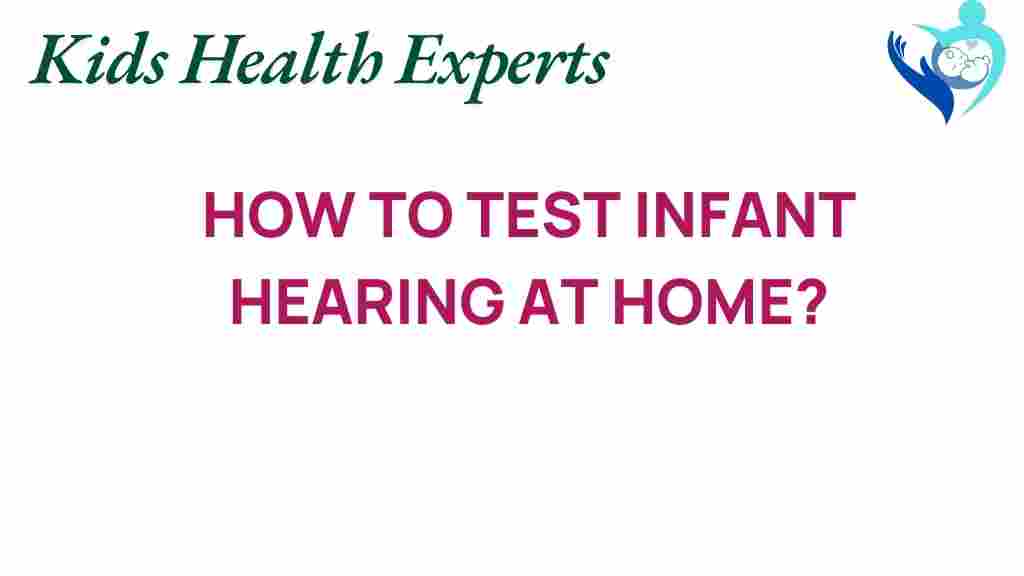Infant Hearing Test: A Parent’s Guide to Home Hearing Assessment
As a new parent, ensuring your infant’s health and development is a top priority. One crucial aspect of this is assessing their hearing ability. Hearing plays a vital role in communication, language development, and social interaction. In this guide, we will explore how to perform an infant hearing test at home, the significance of newborn hearing assessments, and the importance of early detection of hearing issues. By understanding hearing milestones and auditory health, you can be proactive in your child’s development.
Why Infant Hearing Testing is Important
Newborn hearing screening is essential because:
- Approximately 1 to 3 per 1,000 babies are born with hearing loss.
- Early detection can lead to timely intervention, which is crucial for language development.
- Hearing loss can affect social skills, emotional health, and overall quality of life.
Conducting an infant hearing test at home can help you monitor your child’s auditory health and ensure they are meeting important hearing milestones.
Step-by-Step Process for Home Hearing Assessment
Before you begin your home hearing assessment, it is essential to create a conducive environment. Follow these simple steps:
1. Prepare the Environment
Choose a quiet room with minimal background noise. Ensure that distractions are limited, as they can interfere with your assessment.
2. Gather Necessary Materials
You may need:
- A soft toy that makes sound (like a rattle or squeaky toy)
- A smartphone or device with music or sounds
- A timer to track your assessment
3. Observe Your Infant’s Reaction
Start the test by observing how your infant reacts to different sounds:
- Soft Sounds: Use a soft toy to make subtle noises while your baby is focused on something else. Watch for signs of alertness, like turning their head or moving their eyes.
- Louder Sounds: Gradually increase the volume of the sound. A positive response would include your baby looking towards the source of the sound or showing excitement.
4. Utilize Music
Play music at a moderate volume. Note your baby’s reaction. Do they seem to respond to the rhythm or melody? If they smile or move their arms and legs, these are positive signs.
5. Document Your Observations
Take note of how your baby reacts to different sounds. This documentation can help you identify any patterns or concerns you might want to discuss with your pediatrician.
Understanding Hearing Milestones
Being aware of hearing milestones can help you assess your infant’s auditory health more effectively. Here are some key milestones to watch for:
- 0-3 months: Your baby should startle at loud noises and may quiet down or smile when spoken to.
- 4-6 months: Babies often begin to turn their heads towards sounds and may respond to their name.
- 7-12 months: At this stage, infants may recognize common words and can respond to simple requests.
Assessing these milestones during your home hearing assessment can provide valuable insights into your child’s hearing development.
Troubleshooting Tips
If you notice that your infant is not responding to sounds as expected, here are some troubleshooting tips:
- Check for Distractions: Ensure the environment is quiet and free from distractions during your assessment.
- Review Your Methods: Try varying the sounds and volume levels. Some infants may respond better to certain types of sounds.
- Consult Professionals: If you continue to have concerns about your baby’s hearing, consult your pediatrician or a hearing specialist.
When to Seek Professional Help
While home assessments are useful, they are not a substitute for professional evaluations. If you observe any of the following, it’s time to consult a healthcare provider:
- Your baby does not respond to loud sounds.
- There is no response to your voice by six months.
- You notice a regression in response to sounds after showing progress.
Early detection is critical, and if you have any concerns about your infant’s hearing, don’t hesitate to seek professional advice. Your child’s auditory health is paramount.
Conclusion
Conducting an infant hearing test at home can be an empowering experience for parents. Not only does it allow you to monitor your child’s auditory health, but it also helps you understand their development better. Remember to observe hearing milestones, document your findings, and seek professional guidance when necessary.
For more information on hearing health and resources, visit the Centers for Disease Control and Prevention (CDC). This will help you stay updated on the latest recommendations for newborn hearing assessments.
By being proactive and informed, you can play a crucial role in ensuring your child’s optimal hearing and overall development. For further reading on child development stages, check out our parent guide on early childhood milestones.
This article is in the category Care and created by KidsHealthExperts Team
